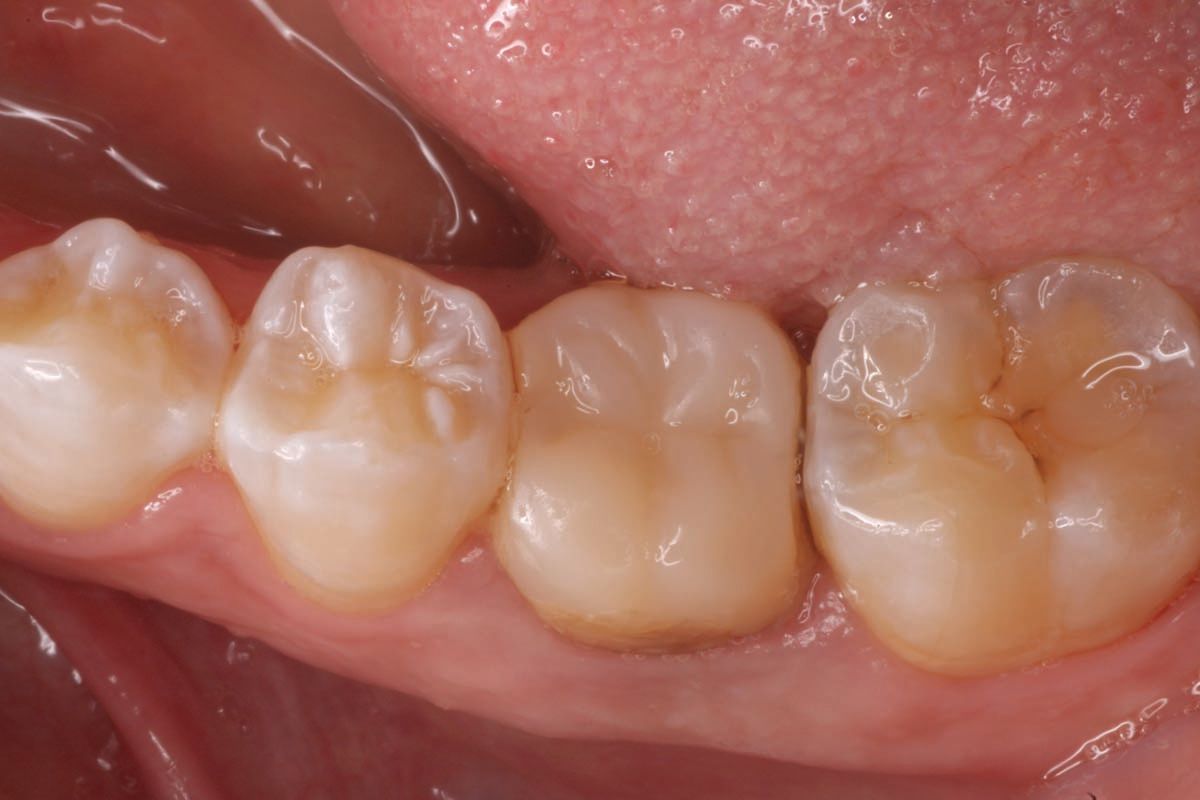Information provided by Kuraray America, Inc.
Restoring severely decayed and damaged teeth is a challenging task in dentistry, so challenging that a significant number of dentists choose not to do it, often opting for an extraction and an implant. However, with the advancement in adhesive systems and composite materials, it is now possible to successfully restore teeth that were previously deemed unrestorable.
This article presents a case study highlighting the successful restoration of a badly broken tooth using a comprehensive treatment approach and superior dental materials. The aim is to shed light on the potential of complex composite restorations and encourage dental professionals to consider this conservative and cost-effective alternative to more invasive treatments.
Case Presentation
The patient, a 33-year-old woman, presented with a broken tooth (#30) as her chief complaint (Figure 1). Prior to treatment, she had excellent oral health with no decay, operative needs, or periodontal issues. The patient had a class I occlusion and was concerned about the broken tooth.
Diagnosis and Treatment Planning
To assess the patient’s oral health, a comprehensive evaluation was conducted, including a full series of x-rays, oral cancer screening, occlusion assessment, and periodontal health evaluation. Considering the patient’s virgin adjacent teeth, I proposed an extraction and bone graft and an immediate placed implant.
CLEARFIL MAJESTY Family of Composites
Kuraray Noritake’s composites are called Majesty and are formulated to reign supreme and deliver dignity and beauty. The line includes CLEARFIL MAJESTY ES-2 Universal, CLEARFIL MAJESTY ES-2 Classic, and CLEARFIL MAJESTY ES-2 Premium. All 3 systems offer a chameleon effect and LD (light-diffusion) Technology.
Kuraray Noritake Dental
800-879-1676
kuraraydental.com
But this treatment, although ideal, did not fit into her present budget. She desired an implant but was going to have to save up the money. The goal, then, was to restore the broken tooth with the anticipation of future implant placement while preserving the interdental space.
Treatment Process
First, the dentin floor was roughened using a diamond bur to aid in composite retention and create a pulp access point of approximately 2 to 3 mm for additional retention. A matrix (Getz Tofflemire from Waterpik) was placed around the tooth, using wedges for adaptation and stability. The exposed enamel was then etched (Etch from BISCO) prior to the application of an adhesive system (CLEARFIL SE Protect by Kuraray America).
Next, CLEARFIL MAJESTY Flow (Kuraray America) was used at the margins in an increment of less than 1 mm. Then CLEARFIL MAJESTY ES-2 Classic (Kuraray America) nano-hybrid composite was applied. Each layer of composite was cured prior to application of the next layer with a VALO Grand Cordless curing light (Ultradent Products, Inc) until final restorative tooth height was achieved. The restoration anatomy was started with an explorer before the final increment was cured. Then the anatomy was fine-tuned using finishing burs (a football bur from Two Striper and a veneer finishing diamond), and the esthetics were enhanced by applying stain (Kolor + Plus composite color from Kerr Dental) to match adjacent teeth (Figures 2 and 3).
Challenges and Unique Aspects
With This Case
Restoring a severely damaged tooth presented several challenges. The size of the restoration pushed the limits of the matrix systems, making adaptation difficult, often requiring the operator to hold the matrix down with their finger. Achieving proper contacts also posed a challenge.
To overcome these hurdles, I utilized various techniques such as restoring buccal and lingual margins first, then using the Contact Pro 2 instrument (Practicon, Inc) for tight contacts and implementing meticulous curing methods.
The success of the treatment was attributed to the use of specific Kuraray products, including CARIES DETECTOR for thorough decay assessment, CLEARFIL SE Protect adhesive system for superior bond strength, and MAJESTY ES-2 Classic composite for layered restoration. These technologies and techniques contributed to the long-lasting success of the restoration.
Treatment Outcomes and
Long-Term Follow-Up
The patient’s satisfaction was addressed by an explanation of the treatment plan and expectations. The final results of the treatment exceeded expectations, with the restoration still intact even years after its placement (Figures 4 and 5). The patient expressed delight in avoiding the previously planned implant and appreciated the preservation of her natural tooth (Figures 6 and 7).
During the patient’s recall appointments, her oral health remained stable, and the restoration was consistently evaluated for longevity. At year 7, the restoration was still functional, showcasing the exceptional longevity of the restoration.
This case highlights the successful restoration of an “unrestorable” tooth, challenging the notion that severely broken teeth are beyond repair. By employing advanced adhesive systems, meticulous techniques, and composite materials, dental professionals can provide conservative, esthetic, and cost-effective alternatives to more invasive treatments.
This case contributes to the field of dentistry by showcasing the potential for long-lasting complex composite restorations. The primary ethical consideration was the uncertainty regarding the longevity of the restoration. My commitment to patient satisfaction and long-term oral health led to a mutual agreement with the patient. If the restoration failed within an unreasonable time, alternative solutions, such as a retainer, would have been provided free of charge.
Summary
The successful restoration of severely broken teeth using composite materials and advanced adhesive system presents a conservative and durable treatment alternative. This case study highlights the importance of comprehensive treatment planning, meticulous techniques, and the selection of optimal dental materials. By adopting these approaches, dental professionals can provide patients with long-lasting, functional, and esthetically pleasing restorations while preserving natural teeth and reducing the need for more invasive interventions.


